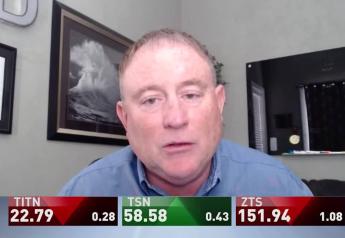Will Fertilizer and Herbicide Prices Fall Before Spring? Why Experts Say It's Highly Unlikely
Battle for Inputs 111721
The supply chain constraints are continuing to plague agriculture, and as farmers work to make input decisions for the 2022 season, economists expect high input prices to persist through spring. One major reason for the severe supply chain constraints is China, as nearly 75% of the active ingredients and crop protection chemicals comes from China.
Despite President Biden and China’s Xi Jinping holding a closely watched virtual meeting last week, the supply chain issues weren’t discussed. As AgWeb has reported, glyphosate prices are up anywhere from 100% to 300% in areas, and that's if you can even get it.
Geopolitical Issues at Play
During a recent supply chain discussion hosted by Farm Journal, RaboResearch analyst Sam Taylor said China is the main source of herbicide supply issues for 2022. Taylor, who researches the farm inputs sector in North America, not only looks at fertilizers and agrochemicals, but the broader farm economy as well.
“Between 70% and 75% of active ingredients do come from China,” Taylor told AgriTalk host Chip Flory. “If you drill down into the data, somewhere close to 90% of the intermediates, which go into the production of active ingredients, are actually sourced from China.”
Nutrien Ag Solutions is also watching the situation. Due to China’s zero-tolerance COVID policy from the start, and implementing strict lockdowns to prevent the spread of the virus, the company reports the U.S. knew farm inputs would see tight supplies, just not this severe.
“Given the fact 70% to 75% of the active ingredients that make up our crop protection chemicals come from China, we knew that there had been slowdowns, lockdowns over there. So we were preparing in some ways, but we really didn't know until March what the full effects were going to be,” says Jeff Tarsi, Nutrien Ag Solutions.
As input prices continue to climb could input prices see relief? Both agricultural economists and farm input analysts say that’s highly unlikely given the current situation.
“I feel that betting on input pricing is basically betting on the benevolence of Xi Jingping and the benevolence of Vladimir Putin, as well as the weather,” says Taylor. “And I think that these are things which you can't necessarily legislate for.”
"The reality is it's a very, very complicated set of factors, from geopolitics, to weather conditions to structural issues," says Allan Gray, who currently serves as director of the Center for Food and Agricultural Business at Purdue University. "Even so much so is that we just don't have enough truck drivers. And that's ultimately what's boiled down to a big, big part of this problem."
Taylor says the input price and supply pain isn’t just a North American issue. He says it’s something plaguing producers worldwide.
“And as we switch and rotate seasons from the northern hemisphere to the southern hemisphere, they're going to start to see other issues themselves. So we're going to see these issues continue for the foreseeable future, for sure.”
Price and supply relief is something ag economists across the country are watching. But with elevated energy prices, as well as supply chain problems that continue to plague the transpiration system, many economists aren’t optimistic on farm input prices falling before spring.
Glufosinate in Tight Supply
It’s not just glyphosate that’s a price and sourcing issue for farmers and ag retailers trying to come up with a chemistry plan for next year. Ag retailers Farm Journal spoke to say glufosinate supplies are also unknown, with prices up 50% or more.
Scott Kay, vice president of BASF’s U.S. Crops division says while supplies are tight, the company is working to get product to retailers before the 2022 growing season. He says the company is working closely with the retail industry as well as farmers to make sure that they all are managing the current supplies situation together, even thinking through other options for managing weeds in 2022.
“Supplies are very tight, but what can we do to manage weeds so that there's fewer post-emerge sprays? Can we put more residual out? Can we manage our weeds differently? The best thing about BASF is that from a technology standpoint, we have a broad portfolio of post-application products, whether that's Engenia, dicamba-tolerant crops, or Liberty that can go across both Enlist, Liberty and Xtend capable traits,” says Kay. “And so for me, there’s just a whole host of ways in which we can manage this.”
Those conversations with ag retailers are already happening. Tarsi says Nutrien has been working closely with its retail locations since summer to start the process of compiling alternative plans to help with the input shortage.
"In late July, August, going into September, (we've thought) that 2022 might be a bigger challenge than 2021 was in a lot of respects. And so we're spending a lot of time right now with our agronomists out in the field and with our customers. Obviously, harvest is is well underway and is really coming along nicely. But we're out right now building crop plans, what our customers are taking into effect, what we know today and that changes on a daily basis."
Kay says longer-term, BASF is investing $260 million into its North America production capacity, which will help production in the future.







